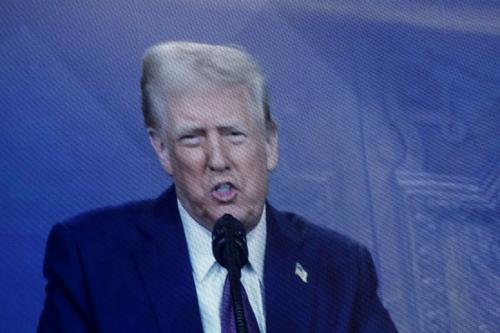This viewpoint is part of USMCA Forward 2024.
The year 2024 marks the 30th anniversary of entry into force of NAFTA, the most modern agreement of its time. It triggered the long and successful integration process that led North America to become one of the most competitive regions in the world.
The 26 years of NAFTA, including three years of a highly complex and ambitious negotiation process, led to the United States-Mexico-Canada Agreement or USMCA,1 which entered into force in July of 2020, consolidating the economic integration of our three countries. USMCA brought a new approach to trade, incorporating new elements in areas such as technology, services, labor, environment, and digitalization, as well as novel dispute settlement mechanisms.
The renegotiation of NAFTA into USMCA showed the importance of trade agreements not staying static and being updated to address new issues and challenges of a changing world.
Our three decades-long tradition of free trade has yielded clear and positive results. Thanks in part to this, our three countries account for almost a third of the world´s GDP, and all three North American economies are among the world´s 20 largest, known as the G20.
By the end of 2023, the trade within our three countries was close to $2 trillion, meaning more than $3 million per minute, and accounting for more than 10 million jobs—while also representing at least 15% of global trade.
The standard bearer of our integration is the automotive industry. As mentioned in U.S. Trade Representative Katherine Tai´s 2022 report, “… industry reports that total auto trade (imports plus exports of vehicles and parts) is the largest component of total North American trade, accounting for 22 percent of total trade under the USMCA.”2
North America produced 14.8 million vehicles in 2022 according to OICA,3 17.4% of the world´s total. And by Q3 of 2023, 18.6% of the global production—with the U.S. and Mexico as two of the world´s top ten producers.
We represent 20.7% of global sales with 16.9 million vehicles sold in 2022.4 The industry accounts for 3.3 million jobs, and the region is a major player in auto parts and expected to be the fastest growing producers over the next six years.
However, USMCA also brought challenges to the auto industry with the strictest requirements in any free trade agreements/regional trade agreements in the world: the highest rules of origin, certifications of labor value content, and steel and aluminum purchases not seen in any other agreements.
In a time of major international events such as a global pandemic, international trade tensions, armed conflict, and in the case of the auto industry, a historic paradigm shift towards new technologies for zero emission vehicles known as electromobility, we must strengthen our efforts to make North America the global powerhouse of electromobility.
This involves ensuring proper implementation and full compliance with USMCA, including the dispute settlement outcomes such as the 2022 panel ruling on rules of origin. Compliance with USMCA reinforces the rule of law and the business certainty needed for the significant new investments required to build an electromobility supply chain.
On this note, the 2026 review must be seen as the opportunity to facilitate the region´s transition to electromobility, rather than make the already high requirements even harder—to the detriment of our shared competitiveness. This will help us to effectively address the future needs of raw materials and renewable energy sources and strengthen our shared capabilities to produce key components such as semiconductors, chips, printed circuit boards, and other technology-based components. It is also essential to develop specialized human capital to attract investments, encourage the adoption of digital technologies, ensure security on all communication routes, and improve border infrastructure.
In conclusion, the success of USMCA will depend on its implementation and compliance. The three countries must work together, anticipate challenges, and seize the opportunities. Moreover, collaboration is key, and projects such as Brookings´ USMCA initiative play an important role. Only by working as a region we will be able to successfully address the global challenges of our times.
-
Acknowledgements and disclosures
With input from Adriana Ramirez, Economic Studies Manager, Mexican Association of the Automotive Industry (AMIA).
AMIA was established in 1951, with the purpose of representing the light vehicles automotive sector in Mexico, promoting its growth and development, as well as providing updated public information on the performance of production, exports, and sales of our affiliated companies. It represents light vehicle manufacturers, importers, and traders before the three levels of government, business chambers, key stakeholders, and the general public. Its current membership is made up of 22 companies. AMIA is a consulting body on government initiatives and public policies, as well as on the negotiations of international trade agreements. It was an active participant in the negotiation processes of what was the NAFTA, and now, with the USMCA, it supports the objectives to increase regional competitiveness, production, and job creation.
-
Footnotes
- USMCA is also known as CUSMA in Canada and TMEC in Mexico.
- USTR, “Report to Congress on the Operation of the United States-Mexico-Canada Agreement with Respect to Trade in Automotive Goods.” July 1, 2022. https://ustr.gov/sites/default/files/2022%20USMCA%20Autos%20Report%20to%20Congress.pdf.
- International Organization of Motor Vehicle Manufacturers. https://www.oica.net/category/production-statistics/2022-statistics/.
- “Sales Statistics | www.oica.net,” n.d., https://www.oica.net/category/sales-statistics/.
The Brookings Institution is committed to quality, independence, and impact.
We are supported by a diverse array of funders. In line with our values and policies, each Brookings publication represents the sole views of its author(s).









Commentary
North America and the automotive industry looking forward
March 6, 2024